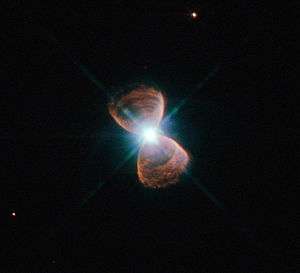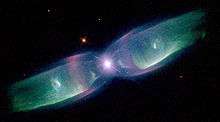Bipolar nebula
A bipolar nebula is a type of nebula characterized by two lobes either side of a central star. About 10-20% of planetary nebulae are bipolar.[2]

Bipolar planetary nebula PN Hb 12.[1]
Formation
Though the exact causes of this nebular structure are not known, it is often thought to imply the presence of a binary central star with a period of a few days to a few years. As one of the two stars expelled its outer layers, the other disrupted the outflow of material to form the bipolar shape.[3]
Examples

Planetary Nebula M2-9, otherwise known as the Twin Jet Nebula or the Wings of a Butterfly Nebula, is a bipolar nebula.
- Homunculus Nebula around Eta Carinae[4][5][6][7]
- Hubble 5[8]
- M2-9 – The Wings of a Butterfly Nebula[9][10][11]
- OH231.8+4.2 – The Calabash Nebula or Rotten Egg Nebula[12][13][14][15]
- Mz3 (or Menzel 3) – The Ant Nebula[16][17][18]
- CRL 2688 – The Egg Nebula[19][20][21][22]
- HD 44179 – The Red Rectangle Nebula[23][24][25]
- MyCn18 – The Engraved Hourglass Nebula[26][27][28][29][30]
- He2-104 – The Southern Crab Nebula[31][32][33]
- The Boomerang Nebula[34][35][36][37][38]
- NGC 2346 – Also known as the Butterfly Nebula[39]
gollark: 819090949453314421828766181031007354770549815968077200947469613436092861484941785017180779306810854690009445899527942439813921350558642219648349151263901280383200109773868066287792397180146134324457264009737425700735921003154150893679300816998053652027600727749674584002836240534603726341655425902760183484030681138185510597970566400750942608788573579603732451414678670368809880609716425849759513806930944940151542222194329130217391253835591503100333032511174915696917450271494331515588540392216409722910112903552181576282328318234254832611191280092825256190205263016391147724733148573910777587442538761174657867116941477642144111126358355387136101102326798775641024682403226483464176636980663785768134920453022408197278564719839630878154322116691224641591177673225326433568614618654522268126887268445968442416107854016768142080885028005414361314623082102594173756238994207571362751674573189189456283525704413354375857534269869947254703165661399199968262824727064133622217892390317608542894373393561889165125042440400895271983787386480584726895462438823437517885201439560057104811949884239060613695734231559079670346149143447886360410318235073650277859089757827273130504889
gollark: J
gollark: Testbot3, take heavpoot's soul.
gollark: Testbot3, take some bees.
gollark: Testbot3, take 6 cryoapioforms.
References
- "Bizarre alignment of planetary nebulae". ESA/Hubble Press Release. Retrieved 6 September 2013.
- The Macquarie/AAO/Strasbourg Hα Planetary Nebula Catalogue: MASH, Parker et al. 2006, MNRAS, 373, 79
- Binary Progenitor Models for Bipolar Planetary Nebulae, Soker 1998, ApJ, 496, 833
- NewsCenter - Doomed Star Eta Carinae (06/10/1996) - Release Images. HubbleSite (10 June 1996). Retrieved on 26 November 2010.
- Nemiroff, R.; Bonnell, J., eds. (12 July 1995). "Eta Carinae Before Explosion". Astronomy Picture of the Day. NASA. Retrieved 26 November 2010.
- Nemiroff, R.; Bonnell, J., eds. (26 March 2006). "Doomed Star Eta Carinae". Astronomy Picture of the Day. NASA. Retrieved 26 November 2010.
- Eta Carinae Nebula (NGC 3372). Daviddarling.info (1 February 2007). Retrieved on 26 November 2010.
- HubbleSite – NewsCenter – Hubble Witnesses the Final Blaze of Glory of Sun-Like Stars (12/17/1997) – Release Images
- Nemiroff, R.; Bonnell, J., eds. (12 June 2005). "M2 9: Wings of a Butterfly Nebula". Astronomy Picture of the Day. NASA. Retrieved 26 November 2010.
- Nemiroff, R.; Bonnell, J., eds. (21 October 1997). "The Butterfly Planetary Nebula". Astronomy Picture of the Day. NASA. Retrieved 26 November 2010.
- Butterfly Nebula (M 2-9). Daviddarling.info (1 February 2007). Retrieved on 26 November 2010.
- NewsCenter - The "Rotten Egg" Nebula: A Planetary Nebula in the Making (10/19/1999) - Introduction. HubbleSite (19 October 1999). Retrieved on 26 November 2010.
- APOD: 1 November 1999 - The Rotten Egg Planetary Nebula. Antwrp.gsfc.nasa.gov (1 November 1999). Retrieved on 26 November 2010.
- Nemiroff, R.; Bonnell, J., eds. (3 September 2001). "The Making of the Rotten Egg Nebula". Astronomy Picture of the Day. NASA. Retrieved 26 November 2010.
- Calabash Nebula (OH231.8+4.2). Daviddarling.info (1 February 2007). Retrieved on 26 November 2010.
- NewsCenter - Astro-Entomology? Ant-like Space Structure Previews Death of Our Sun (02/01/2001) - Introduction. HubbleSite (1 February 2001). Retrieved on 26 November 2010.
- Nemiroff, R.; Bonnell, J., eds. (1 May 2005). "Planetary Nebula Mz3: The Ant Nebula". Astronomy Picture of the Day. NASA. Retrieved 26 November 2010.
- Ant Nebula (Menzel 3). Daviddarling.info (1 February 2007). Retrieved on 26 November 2010.
- NewsCenter - Hubble Finds Searchlight Beams and Multiple Arcs around a Dying Star (01/16/1996) - Introduction. HubbleSite (16 January 1996). Retrieved on 26 November 2010.
- Nemiroff, R.; Bonnell, J., eds. (26 June 1999). "Shells in the Egg Nebula". Astronomy Picture of the Day. NASA. Retrieved 26 November 2010.
- Nemiroff, R.; Bonnell, J., eds. (9 April 2003). "The Egg Nebula in Polarized Light". Astronomy Picture of the Day. NASA. Retrieved 26 November 2010.
- Egg Nebula (CRL 2688). Daviddarling.info (1 February 2007). Retrieved on 26 November 2010.
- NewsCenter - Dying Star Sculpts Rungs of Gas and Dust (05/11/2004) - Release Images. HubbleSite (11 May 2004). Retrieved on 26 November 2010.
- Nemiroff, R.; Bonnell, J., eds. (13 May 2004). "Rungs of the Red Rectangle". Astronomy Picture of the Day. NASA. Retrieved 26 November 2010.
- Red Rectangle. Daviddarling.info (1 February 2007). Retrieved on 26 November 2010.
- NewsCenter - Hubble Finds an Hourglass Nebula around a Dying Star (01/16/1996) - Release Images. HubbleSite (16 January 1996). Retrieved on 26 November 2010.
- Nemiroff, R.; Bonnell, J., eds. (18 January 1996). "MyCn18: An Hourglass Nebula". Astronomy Picture of the Day. NASA. Retrieved 26 November 2010.
- Nemiroff, R.; Bonnell, J., eds. (15 June 2002). "MyCn18: An Hourglass Nebula". Astronomy Picture of the Day. NASA. Retrieved 26 November 2010.
- Nemiroff, R.; Bonnell, J., eds. (9 February 1996). "The Eye of an Hourglass Nebula". Astronomy Picture of the Day. NASA. Retrieved 26 November 2010.
- Hourglass Nebula (MyCn 18). Daviddarling.info (1 February 2007). Retrieved on 26 November 2010.
- NewsCenter - Symbiotic Star Blows Bubbles into Space (08/24/1999) - Release Images. HubbleSite (24 August 1999). Retrieved on 26 November 2010.
- Nemiroff, R.; Bonnell, J., eds. (31 August 1999). "Symbiotic Star Bubbles". Astronomy Picture of the Day. NASA. Retrieved 26 November 2010.
- Southern Crab Nebula (He2-104) Archived 9 October 2006 at the Wayback Machine. Daviddarling.info (1 February 2007). Retrieved on 26 November 2010.
- NewsCenter - Hubble Catches Scattered Light from the Boomerang Nebula (09/13/2005) - Release Images. HubbleSite (13 September 2005). Retrieved on 26 November 2010.
- Nemiroff, R.; Bonnell, J., eds. (14 September 2005). "The Boomerang Nebula in Polarized Light". Astronomy Picture of the Day. NASA. Retrieved 26 November 2010.
- Nemiroff, R.; Bonnell, J., eds. (20 February 2003). "Cold Wind from the Boomerang Nebula". Astronomy Picture of the Day. NASA. Retrieved 26 November 2010.
- Nemiroff, R.; Bonnell, J., eds. (15 October 1997). "Cold Wind From The Boomerang Nebula". Astronomy Picture of the Day. NASA. Retrieved 26 November 2010.
- Boomerang Nebula. Daviddarling.info (1 February 2007). Retrieved on 26 November 2010.
- APOD: 28 October 2001 – NGC 2346: A Butterfly-Shaped Planetary Nebula
See also
This article is issued from Wikipedia. The text is licensed under Creative Commons - Attribution - Sharealike. Additional terms may apply for the media files.